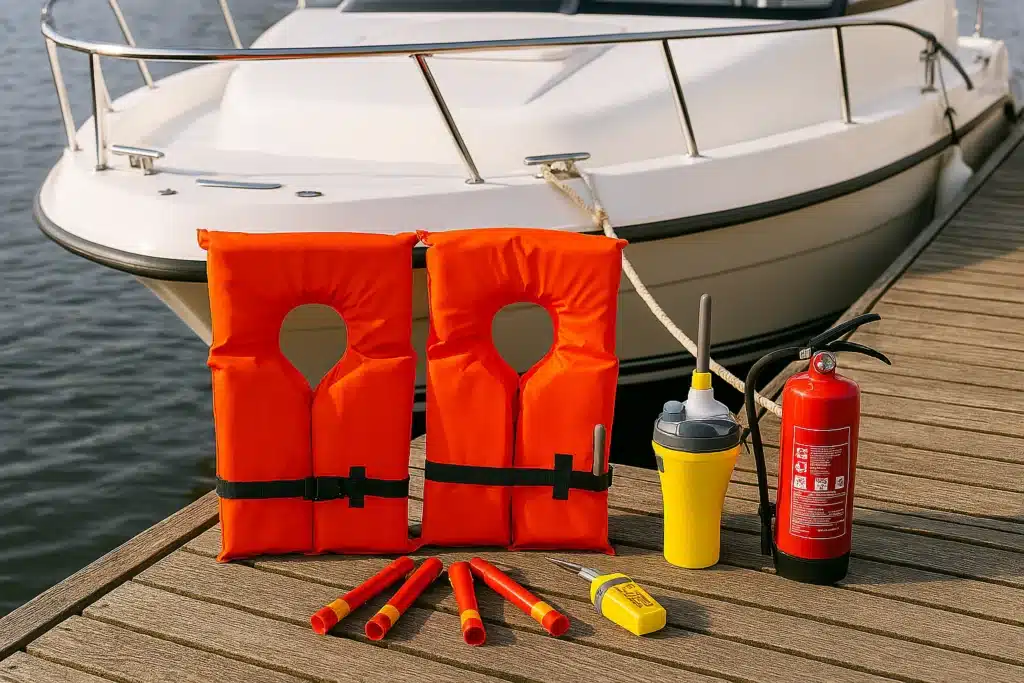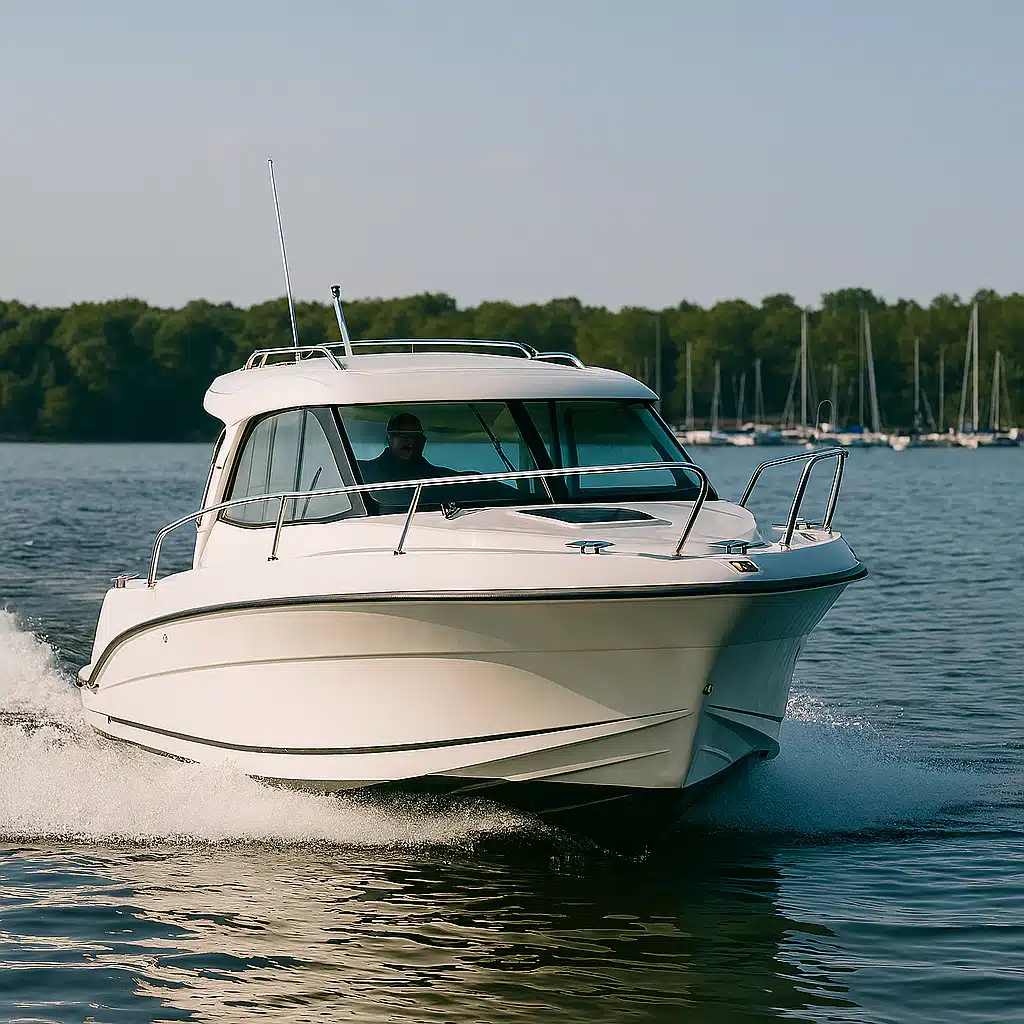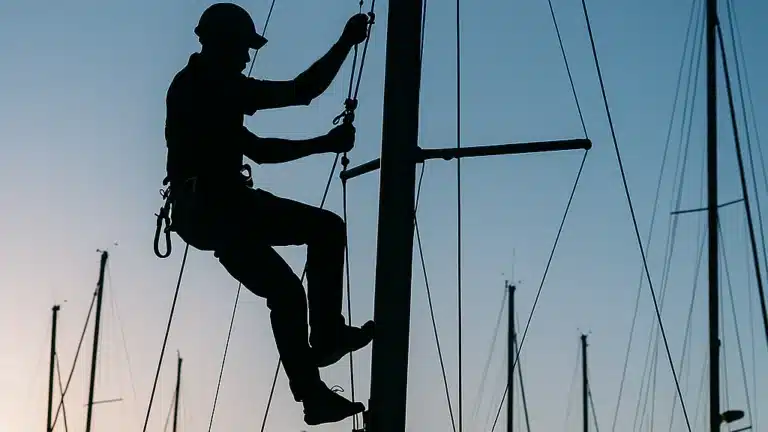When the season turns and the water’s calling, you want the day to be about cruising and fishing — not troubleshooting. A quick, methodical boat pre‑season checklist saves time, money, nasty surprises, and worry. This guide walks you through the checks that matter for pleasure boats and smaller commercial craft (roughly up to 25 m).
Most of this guide can be used as an end-of-season checklist, too.
Download a sample checklist based on this article.
Start every job with safety and preparation. Read the equipment manual for manufacturer‑specific steps, isolate power (including batteries) and fuel where required, and wear appropriate PPE. Work methodically — move from one system to the next, record what you do, and make a list of defects requiring follow-up if you don’t rectify it immediately.
Generic procedure for any item
- Visual inspection first: look for corrosion, cracked or swollen components, frayed wiring, fluid stains, loose fasteners, water ingress and damaged seals. Small issues often become big problems if left.
- Check moving parts by hand: hinges, shafts, couplings, winch drums, and control linkages should move freely. Feel for play, binding, roughness or grit that suggests contamination or wear.
- Clean contact surfaces and terminals: remove salt, grit and old grease before applying fresh lubricant or protective coatings.
- Lubricate correctly: use the manufacturer’s recommended grease or oil and apply the right amount. Too much grease can trap debris, push seals out of place, or make a mess; too little won’t provide adequate protection.
- Electrical checks: after mechanical checks are complete, reconnect the power safely. Watch for abnormal heat, smells, sparks or tripped breakers. If you have the capability, monitor current draw on larger items and make notes so that you can compare with past or future records. Increased current draw can be an early warning sign. Confirm wiring and terminals are secure and corrosion‑free.
- Functional test: Operate the item of load initially and then, where safe, under load, to confirm its performance. For engines and major systems, follow up with a controlled sea trial.
- Record and act: log what you checked, consumables that you replaced (filters, impellers, fluids) and any defects — tag items needing repair and schedule follow‑up.
When to call a professional
- Fuel system pressure testing, fuel line replacement or tank repairs (risk of fire, contamination or spills into the environment).
- Gas cooker and heater certification.
- Major engine repairs, coolant system pressure tests or internal diagnostics.
- High‑voltage electrical work, EWOF, etc..
- Structural repairs, propeller shaft alignment and underwater hull work, including through‑hull replacements.
- Certification, compliance and safety equipment servicing where a recognised inspection or stamp is required.
Boat Pre‑Season Checklist
Your boat pre-season checklist should include at least the following generic points. Tailor your checklist to your own boat and tweak it over the years as your experience grows. Download a sample checklist based on this article.
Key system checks
1) Hull and deck
- Inspect the hull for rust, cracks, blisters, delamination or impact damage. Clean and note any suspect areas for repair. Treat rust spots immediately. Rusty stains below stainless steel fittings should be traced back to the source and thoroughly checked.
- Operate seacocks; they should open and close smoothly, and there should be no sign of leaking, such as salt deposits.
- Check deck fittings, stanchions and cleats; anything that is bolted down to the deck, tighten fastenings and inspect for leaks around mounting points.
- Check anchor chain for wear, length markers, that shackles are tight and correctly moused (wired so the pin can’t work loose, don’t use plastic cable ties).
- Mooring lines and chafe gear: Check for fraying or general wear and tear, repair or replace.
2) Propulsion and steering
- Engine: change oil and filters, inspect belts, hoses and mounts, and replace impellers as needed.
- Fuel: drain or replace stale fuel, check fuel lines, clamps and filters for leaks or contamination. Consider polishing your fuel if it has been sitting for a while.
- Steering: grease cables, inspect hydraulic lines and test the full range of motion. Correct any play in linkages.
3) Electrical and electronics
- Batteries: charge fully, load‑test, clean terminals and check that they are secure, check acid levels and SG (Specific Gravity) where applicable. Replace batteries showing poor performance.
- Lighting and nav gear: verify all navigation lights, deck lights, and instrument backlights work. Power up chart plotters, radar, sonar and VHF radios — back up configurations where possible.
- Cables and connectors: inspect for chafe, corrosion or loose connections. Saltwater intrusion here causes many mid‑season failures.
4) Safety equipment

- Lifejackets and harnesses: inspect for tears, damaged buckles, and, if inflatable, check cylinders and service dates.
- Fire extinguishers: confirm charge, expiry date and service as required. (Seek a technician for recharging or replacement if uncertain.)
- Flares, EPIRBs/PLBs: check expiry dates and run self‑tests where possible. Check that EPIRBs and PLBs have been correctly registered.
- Bilge pumps and alarms: test manual and electric pumps, and confirm that float switches and high‑water alarms operate.
- MOB Gear: Check that it is correctly installed and easily deployed. If the batteries on any lights are disposable, replace them with fresh sets; otherwise, check expiry dates.
5) Plumbing and freshwater systems
- Hoses and clamps: replace where cracked, soft or corroded. Use marine‑grade clamps on all pressure lines.
- Water tanks: flush and sanitise before first use.
- Heads and holding tanks: test macerators, valves and vents for correct operation and smell; inspect for leaks.
6) Paperwork and compliance
- Documents: confirm registrations, radio licence, insurance and any required certifications or inspections are current.
- Charts and software: update electronic charts and instrument firmware where recommended, and back up configurations.
- Tide tables and almanacs: Check that you have up-to-date tide tables and almanacs suitable for your sailing area aboard.
- Radio frequencies and callsign: Check that your local VHF or HF SSB radio frequencies have not changed and that your vessel’s callsign and emergency calling procedure are displayed clearly within sight of the radio.
7) Rig, Rigging and Sails
- Inspect all rigging terminals at deck level: Check for deformity, stains and that all locking pins are in place.
- Visually inspect the rig aloft, use binoculars.
- If you are competent, go up the rig and inspect all terminals, fittings and locking pins.
- While you are up there, check the sheaves for the halyards.
- Pay particular attention to roller furlers and the stay that they run on.
- Check the windex and wind instrument transducers for freedom of movement and secure mounting.
- VHF antenna and cable: check that the connector at the base of the antenna is tight.
8) Sea trial

- After dockside checks, run a controlled shakedown. Test the engines at cruising RPM, confirm cooling, observe exhaust and check for smoke or vibration. Test the autopilot and electronics integration, and try the anchoring gear. Note any unusual noises, vibrations or alarms and investigate.
Final thoughts
A proper boat pre‑season checklist and routine is more than ticking boxes — it builds confidence that your vessel will perform when it matters. Some checks are straightforward DIY; others carry safety, legal or operational risk and should be handled by a qualified technician. Keep a maintenance log, be conservative about safety, and schedule regular professional servicing where your vessel or local regulations require it. Enjoy the season — prepared and confident.
Download a sample boat pre-season checklist based on this article.
What should I check before the boating season starts?
Do a methodical pre‑season inspection: hull/deck, seacocks, engine, fuel, batteries, electronics, safety gear, plumbing, rigging and sails (if applicable) and finish with a controlled sea trial.
What’s a quick pre‑launch checklist if I’m short on time?
Visual hull/deck check, open/close seacocks, test bilge pumps, charge/load‑test batteries, verify nav lights and VHF, check fuel for water/staleness, and run the engine briefly at cruising RPM.
How do I inspect the hull and seacocks?
Look for cracks, blisters, rust and delamination; operate seacocks to ensure they open/close smoothly and show no leaks or salt deposits. Note suspect areas for repair.
What should I do about fuel that’s been sitting all winter?
Drain or polish stale fuel, inspect fuel lines, clamps and filters for leaks/contamination, and consult a pro for tank repairs or pressure testing.
What battery and electrical checks prevent mid‑season failures?
Fully charge and load‑test batteries, clean terminals and check that they are tight, inspect cables/connectors for corrosion or chafe, watch for abnormal heat or smells when powering systems and back-up device configurations.
What safety equipment must I check before sailing?
Inspect lifejackets/harnesses, confirm fire extinguisher charge/expiry, check flares/EPIRB/PLB expiry and registration, and test bilge pumps and high‑water alarms, test gas alarm, check batteries in MOB lights.
What engine and propulsion checks are essential?
Change oil/filters, inspect belts/hoses/mounts, replace impeller if needed, check shaft/prop for damage and verify cooling and exhaust during a sea trial.
How do I check plumbing and freshwater systems?
Replace cracked hoses and marine clamps, flush and sanitise tanks, and test heads, macerators, valves and vents for leaks and odour.
How should I record pre‑season checks?
Keep a dated log of inspections, parts/consumables replaced and current‑draw or performance notes so you can track trends year‑to‑year.
What should I inspect on the rig and sails?
At deck level, check terminals and locking pins. Use binoculars for the rig aloft; if competent, climb to inspect sheaves, fittings and roller furlers. Check windex/wind transducers and VHF antenna base.



